Analysis of Typhoon-Induced Waves along Typhoon Tracks in the Western North Pacific Ocean, 1998–2017
Abstract
:1. Introduction
2. Materials and Methods
3. Results
3.1. Classification of Typhoon Tracks
3.2. Parameters of Typhoon-Induced Waves
3.3. Analysis of the Leading EOF Modes of Significant Wave Height Variation
4. Discussion
5. Conclusions
Author Contributions
Funding
Acknowledgments
Conflicts of Interest
References
- Yuan, J.P.; Jiang, J. The relationships between tropical cyclone tracks and local SST over the western north pacific. J. Trop. Meteorol. 2011, 17, 120–127. [Google Scholar]
- Kim, H.K.; Seo, K.H. Cluster analysis of tropical cyclone tracks over the western north pacific using a self-organizing map. J. Clim. 2016, 29, 3731–3750. [Google Scholar] [CrossRef]
- Akpınar, A.; Vledder, G.P.V.; Kömürcü, M.İ.; Özger, M. Evaluation of the numerical wave model (SWAN) for wave simulation in the Black Sea. Cont. Shelf Res. 2012, 50, 80–99. [Google Scholar] [CrossRef]
- Kim, T.R.; Lee, J.H. Comparison of high wave hindcasts during Typhoon Bolaven (1215) using SWAN and WAVEWATCH III model. J. Coast. Res. 2018, 85, 1096–1100. [Google Scholar] [CrossRef]
- Bi, F.; Song, J.B.; Wu, K.J.; Xu, Y. Evaluation of the simulation capability of the Wavewatch III model for Pacific Ocean wave. Acta Oceanol. Sin. 2015, 34, 43–57. [Google Scholar] [CrossRef]
- Zheng, K.W.; Sun, J.; Guan, C.L.; Shao, W.Z. Analysis of the global swell and wind sea energy distribution using WAVEWATCH III. Adv. Meteorol. 2016, 2016, 8419580. [Google Scholar] [CrossRef] [Green Version]
- Shukla, R.P.; Kinter, J.L.; Shin, C.S. Sub-seasonal prediction of significant wave heights over the Western Pacific and Indian Oceans, part II: The impact of ENSO and MJO. Ocean Model. 2018, 123, 1–15. [Google Scholar] [CrossRef]
- He, H.L.; Xu, Y. Wind-wave hindcast in the Yellow Sea and the Bohai Sea from the year 1988 to 2002. Acta Oceanol. Sin. 2016, 35, 46–53. [Google Scholar] [CrossRef]
- Zheng, K.W.; Osinowo, A.A.; Sun, J.; Hu, W. Long-term characterization of sea conditions in the East China Sea using significant wave height and wind speed. J. Ocean Univ. China 2018, 17, 733–743. [Google Scholar] [CrossRef]
- Gallagher, S.; Tiron, R.; Dias, F. A long-term nearshore wave hindcast for Ireland: Atlantic and Irish Sea coasts (1979–2012). Ocean Dyn. 2014, 64, 1163–1180. [Google Scholar] [CrossRef]
- Guo, L.L.; Perrie, W.; Long, Z.X.; Toulany, B.; Sheng, J.Y. The impacts of climate change on the autumn North Atlantic wave climate. Atmosphere-Ocean 2015, 53, 491–509. [Google Scholar] [CrossRef]
- Shao, W.Z.; Sheng, Y.X.; Li, H.; Shi, J.; Ji, Q.Y.; Tai, W.; Zuo, J.C. Analysis of wave distribution simulated by WAVEWATCH-III model in typhoons passing Beibu Gulf, China. Atmosphere 2018, 8, 265. [Google Scholar] [CrossRef] [Green Version]
- Sheng, Y.X.; Shao, W.Z.; Li, S.Q.; Zhang, Y.M.; Yang, H.W.; Zuo, J.C. Evaluation of typhoon waves simulated by WaveWatch-III model in shallow waters around Zhoushan islands. J. Ocean Univ. China 2019, 19, 365–375. [Google Scholar] [CrossRef]
- Fan, Y.; Lin, S.J.; Held, I.M.; Yu, Z.; Tolman, H.L. Global ocean surface wave simulation using a coupled atmosphere-wave model. J. Clim. 2012, 25, 6233–6252. [Google Scholar] [CrossRef]
- Gallagher, S.; Gleeson, E.; Tiron, R.; Mcgrath, R.; Dias, F. Wave climate projections for Ireland for the end of the 21st century including analysis of EC-Earth winds over the North Atlantic Ocean. Int. J. Clim. 2016, 36, 4592–4607. [Google Scholar] [CrossRef]
- Li, S.Q.; Guan, S.D.; Hou, Y.J.; Liu, Y.H.; Bi, F. Evaluation and adjustment of altimeter measurement and numerical hindcast in wave height trend estimation in China’s coastal seas. Int. J. Appl. Earth Obs. Geoinf. 2018, 67, 161–172. [Google Scholar] [CrossRef]
- Li, X.F. The first Sentinel-1 SAR image of a typhoon. Acta Oceanol. Sin. 2015, 34, 1–2. [Google Scholar] [CrossRef]
- Li, X.F.; Zhang, J.A.; Yang, X.F.; Pichel, W.G.; DeMaria, M.; Long, D.; Li, Z.W. Tropical cyclone morphology from spaceborne synthetic aperture radar. Bull. Am. Meteorol. Soc. 2013, 94, 215–230. [Google Scholar] [CrossRef] [Green Version]
- Ji, Q.Y.; Shao, W.Z.; Sheng, Y.X.; Yuan, X.Z.; Sun, J.; Zhou, W.; Zuo, J.C. A promising method of cyclone wave retrieval from Gaofen-3 synthetic aperture radar image in VV-polarization. Sensors 2018, 18, 2064. [Google Scholar] [CrossRef] [PubMed] [Green Version]
- Romeiser, R.; Graber, H.C.; Caruso, M.J.; Jensen, R.E.; Walker, D.T.; Cox, A.T. A new approach to ocean wave parameter estimates from C-band ScanSAR images. IEEE Trans. Geosci. Remote Sens. 2015, 53, 1320–1345. [Google Scholar] [CrossRef]
- Shao, W.Z.; Li, X.F.; Hwang, P.A.; Zhang, B.; Yang, X.F. Bridging the gap between cyclone wind and wave by C-band SAR measurements. J. Geophys. Res. Oceans 2017, 122, 6714–6724. [Google Scholar] [CrossRef]
- Shao, W.Z.; Hu, Y.Y.; Yang, J.S.; Nunziata, F.; Sun, J.; Li, H.; Zuo, J.C. An empirical algorithm to retrieve significant wave height from Sentinel-1 synthetic aperture radar imagery collected under cyclonic conditions. Remote Sens. 2018, 10, 1367. [Google Scholar] [CrossRef] [Green Version]
- Ding, Y.Y.; Zuo, J.C.; Shao, W.Z.; Shi, J.; Yuan, X.Z.; Sun, J.; Hu, J.C.; Li, X.F. Wave parameters retrieval for dual-polarization C-band synthetic aperture radar using a theoretical-based algorithm under cyclonic conditions. Acta Oceanol. Sin. 2019, 38, 21–31. [Google Scholar] [CrossRef]
- Chen, Y.P.; Xie, D.M.; Zhang, C.K.; Qian, X.S. Estimation of long-term wave statistics in the East China Sea. J. Coast. Res. 2013, 65, 177–182. [Google Scholar] [CrossRef]
- Hwang, P.A.; Bratos, S.M.; Teague, W.J.; Wang, D.W.; Jacobs, G.A.; Resio, D.T. Winds and waves in the yellow and east China seas: A comparison of space-borne altimeter measurements and model results. J. Oceanogr. 1999, 55, 307–325. [Google Scholar] [CrossRef]
- Liang, B.C.; Liu, X.; Li, H.J.; Wu, Y.J.; Lee, D.Y. Wave Climate Hindcasts for the Bohai Sea, Yellow Sea, and East China Sea. J. Coast. Res. 2014, 32, 172–180. [Google Scholar]
- Markina, M.Y.; Gavrikov, A.V. Wave climate variability in the North Atlantic in recent decades in the winter period using numerical modeling. Oceanology 2016, 56, 320–325. [Google Scholar] [CrossRef]
- Divinsky, B.V.; Kosyan, R.D. Spatiotemporal variability of the Black Sea wave climate in the last 37 years. Cont. Shelf Res. 2017, 136, 1–19. [Google Scholar] [CrossRef]
- Caires, S.; Swail, V.R.; Wang, X.L.L. Projection and Analysis of Extreme Wave Climate. J. Clim. 2006, 19, 5581–5605. [Google Scholar] [CrossRef]
- Li, J.X.; Chen, Y.Q.; Pan, S.Q. Modelling of Extreme Wave Climate in China Seas. J. Coast. Res. 2016, 75, 522–526. [Google Scholar] [CrossRef] [Green Version]
- He, H.L.; Song, J.B.; Bai, Y.F.; Xu, Y.; Wang, J.J.; Bi, F. Climate and extrema of ocean waves in the East China Sea. Sci. China Earth Sci. 2018, 7, 1–15. [Google Scholar] [CrossRef]
- Sartini, L.; Mentaschi, L.; Besio, G. Comparing different extreme wave analysis models for wave climate assessment along the Italian coast. Coast. Eng. 2015, 100, 37–47. [Google Scholar] [CrossRef]
- Suursaar, Ü.; Kullas, T. Decadal changes in wave climate and sea level regime: The main causes of the recent intensification of coastal geomorphic processes along the coasts of Western Estonia? WIT Trans. Ecol. Environ. 2009, 126, 105–116. [Google Scholar]
- Shimura, T.; Mori, N.; Mase, H. Future Projection of Ocean Wave Climate: Analysis of SST Impacts on Wave Climate Changes in the Western North Pacific. J. Clim. 2015, 28, 3171–3190. [Google Scholar] [CrossRef] [Green Version]
- Niroomandi, A.; Maa, G.F.; Ye, X.Y.; Lou, S.; Xue, P.F. Extreme value analysis of wave climate in Chesapeake Bay. Ocean Eng. 2018, 159, 22–36. [Google Scholar] [CrossRef]
- Liu, Q.X.; Babanin, A.; Fan, Y.L.; Zieger, S.; Guan, C.L.; Moon, I.J. Numerical simulations of ocean surface waves under hurricane conditions: Assessment of existing model performance. Ocean Model. 2017, 118, 73–93. [Google Scholar] [CrossRef]
- Zieger, S.; Babanin, A.V.; Rogers, W.E.; Young, I.R. Observation-based source terms in the third-generation wave model WAVEWATCH. Ocean Model. 2015, 96, 2–25. [Google Scholar] [CrossRef] [Green Version]
- Weatherall, P.; Marks, K.M.; Jakobsson, M.; Schmitt, T.; Tani, S.; Arndt, J.E.; Rovere, M.; Chayes, D.; Ferrini, V.; Wigley, R. A new digital bathymetric model of the world’s oceans. Earth Space Sci. 2015, 2, 331–345. [Google Scholar] [CrossRef]
- Nakamura, J.; Lall, U.; Kushnir, Y.; Camargo, S.J. Classifying North Atlantic Tropical Cyclone Tracks by Mass Moments. J. Clim. 2009, 22, 5481–5494. [Google Scholar] [CrossRef]
- Yin, H.; Wang, Y.Q.; Zhong, W. Characteristics and influence factors of the rapid intensification of tropical cyclone with different tracks in Northwest Pacific. J. Meteorol. Sci. 2016, 36, 194–203. (In Chinese) [Google Scholar]
- Zhu, Z.X.; Zhou, K. Simulation and Analysis of Ocean Wave in the Northwest Pacific Ocean. Appl. Mech. Mater. 2012, 212, 430–435. [Google Scholar] [CrossRef]
- North, G.R.; Bell, T.L.; Cahalan, R.F.; Moeng, F.J. Sampling Errors in the Estimation of Empirical Orthogonal Functions. Mon. Weather Rev. 1982, 110, 699. [Google Scholar] [CrossRef]
- Wang, J.; Dong, C.M.; He, Y.J. Wave climatological analysis in the East China Sea. Cont. Shelf Res. 2016, 120, 26–40. [Google Scholar] [CrossRef]
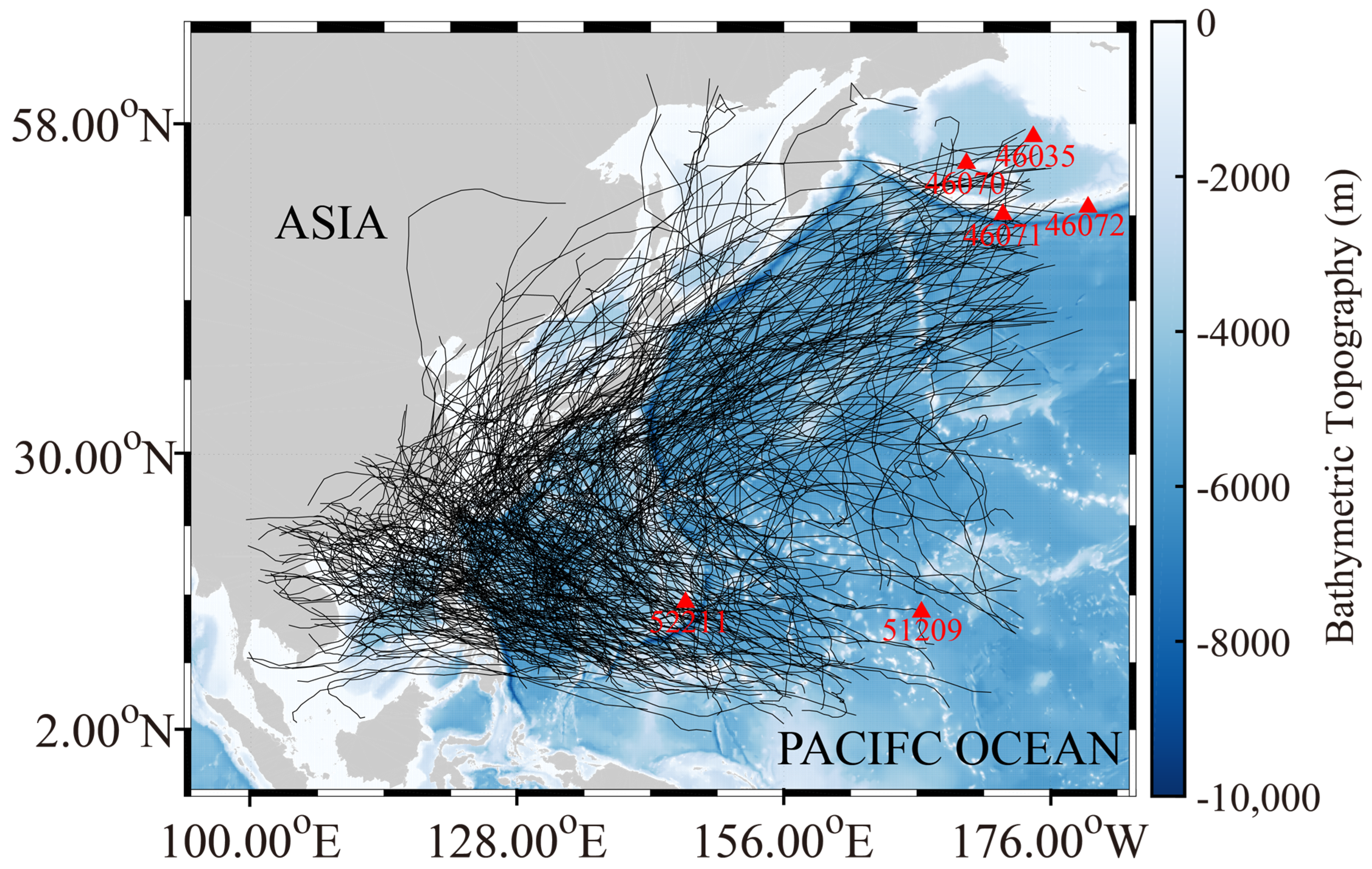

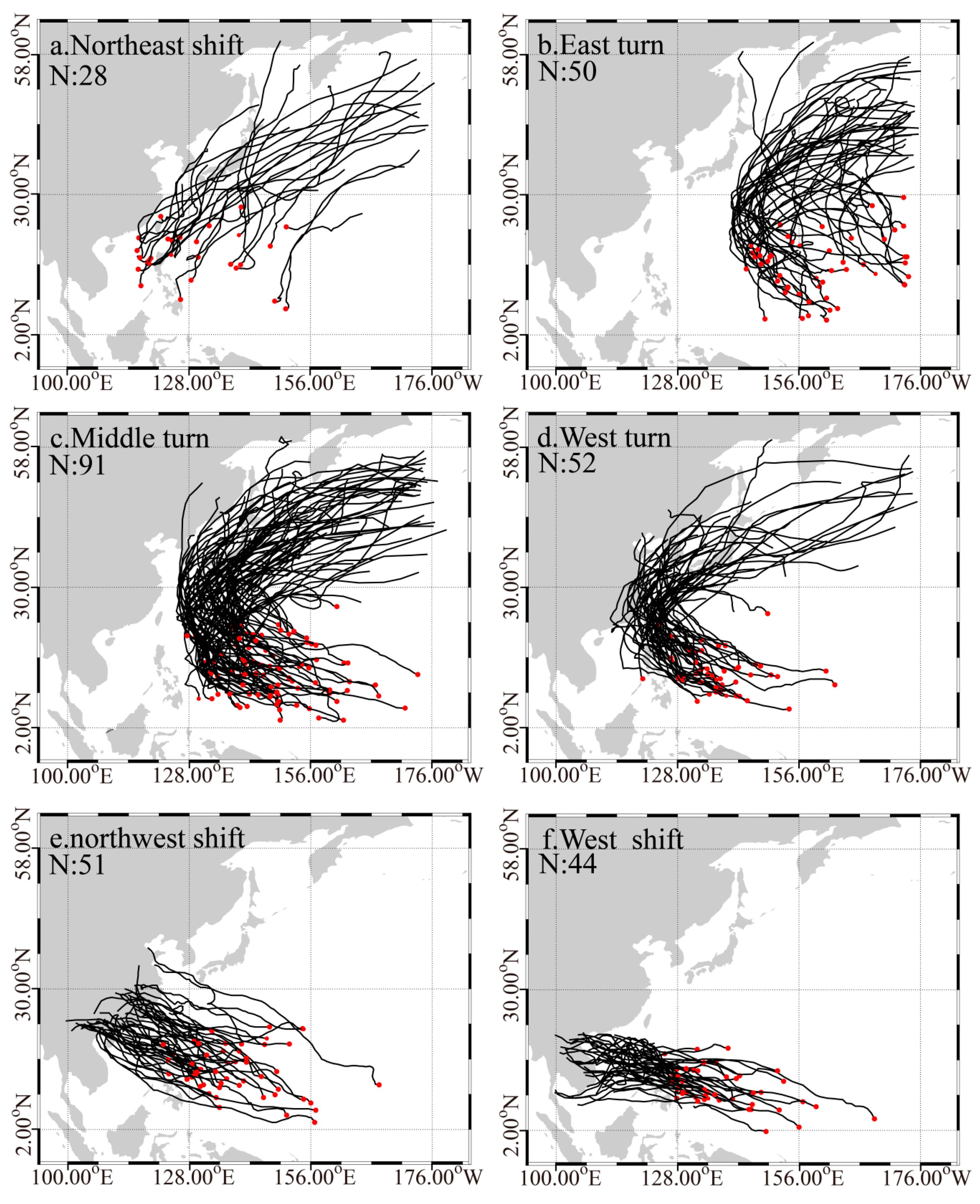
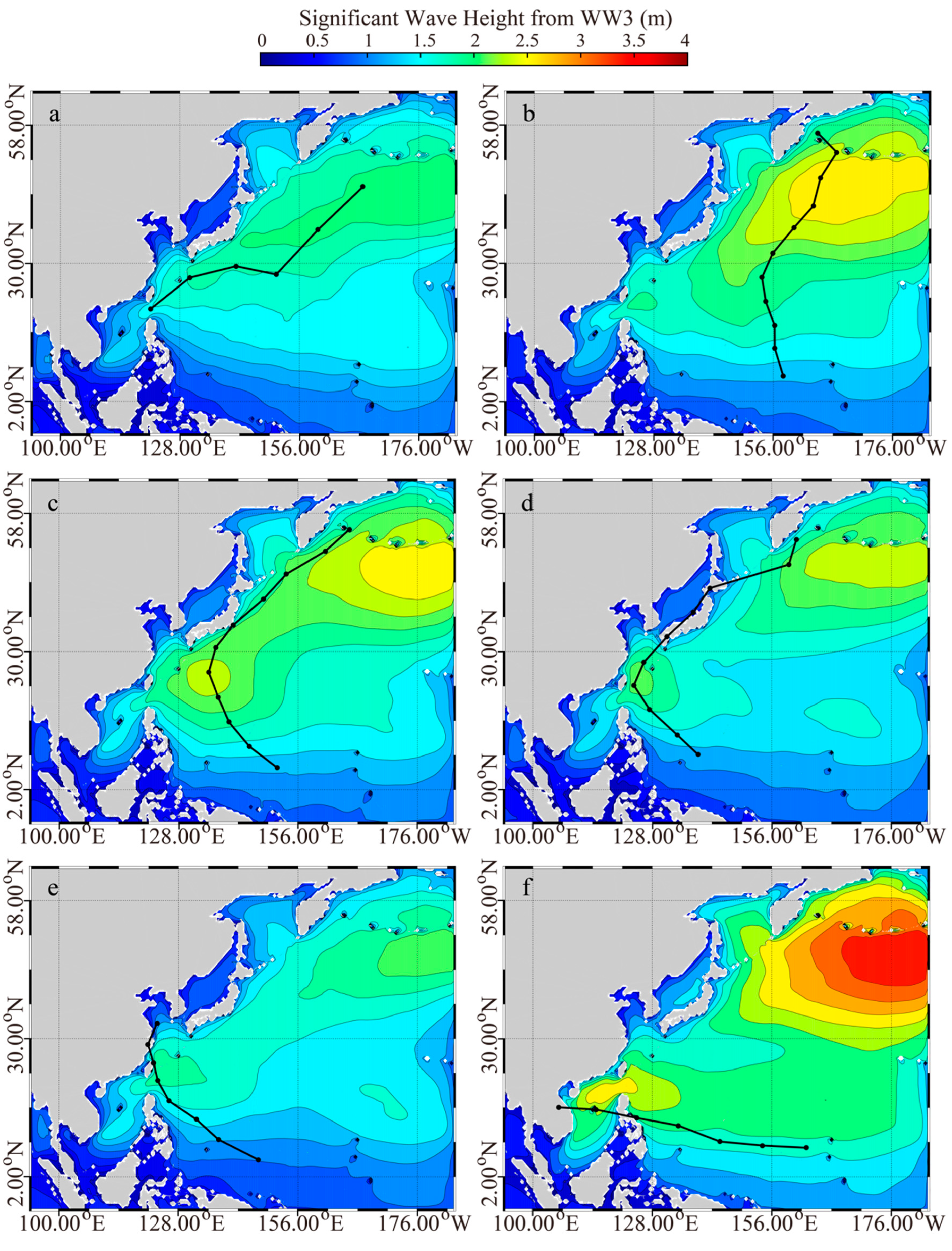



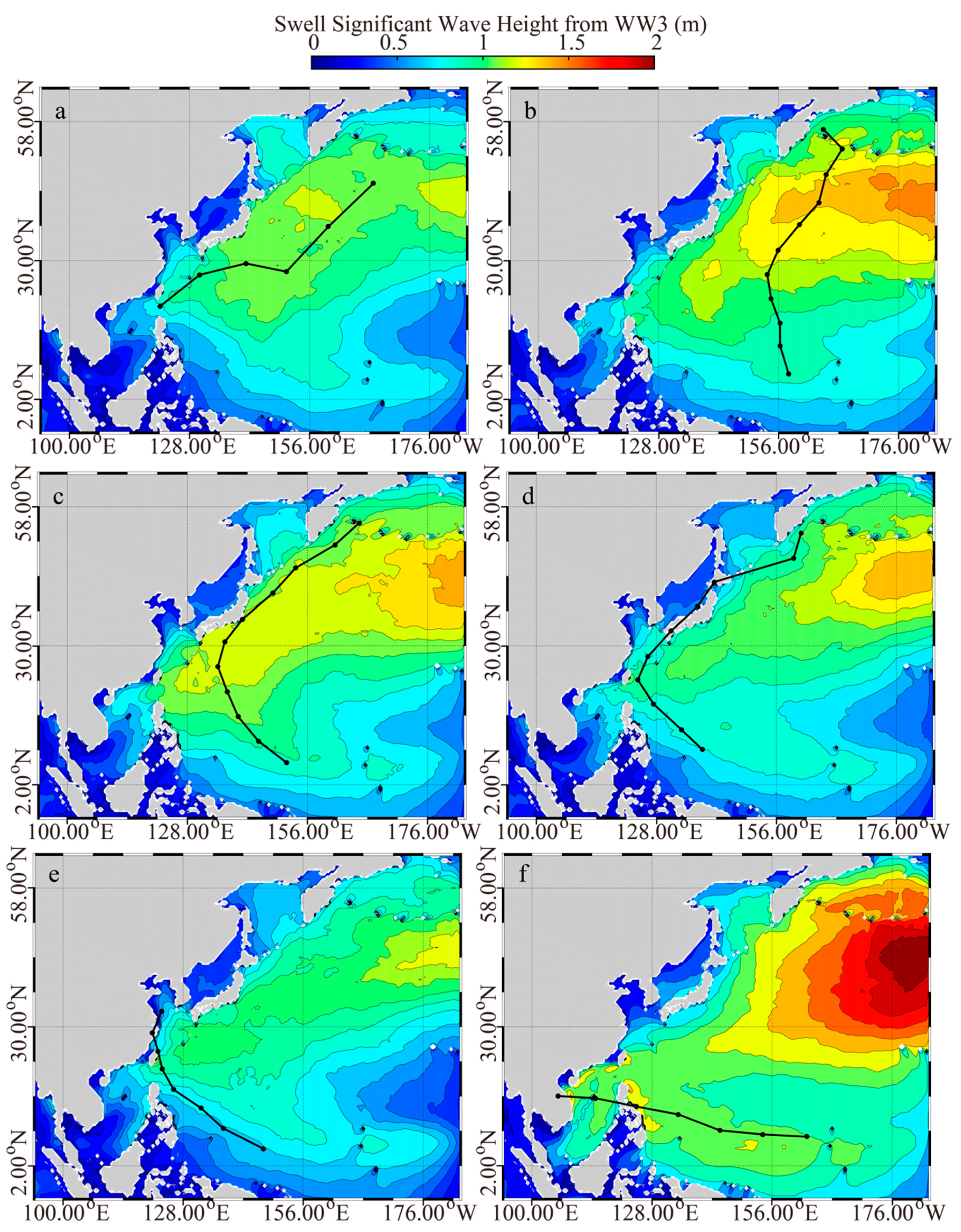
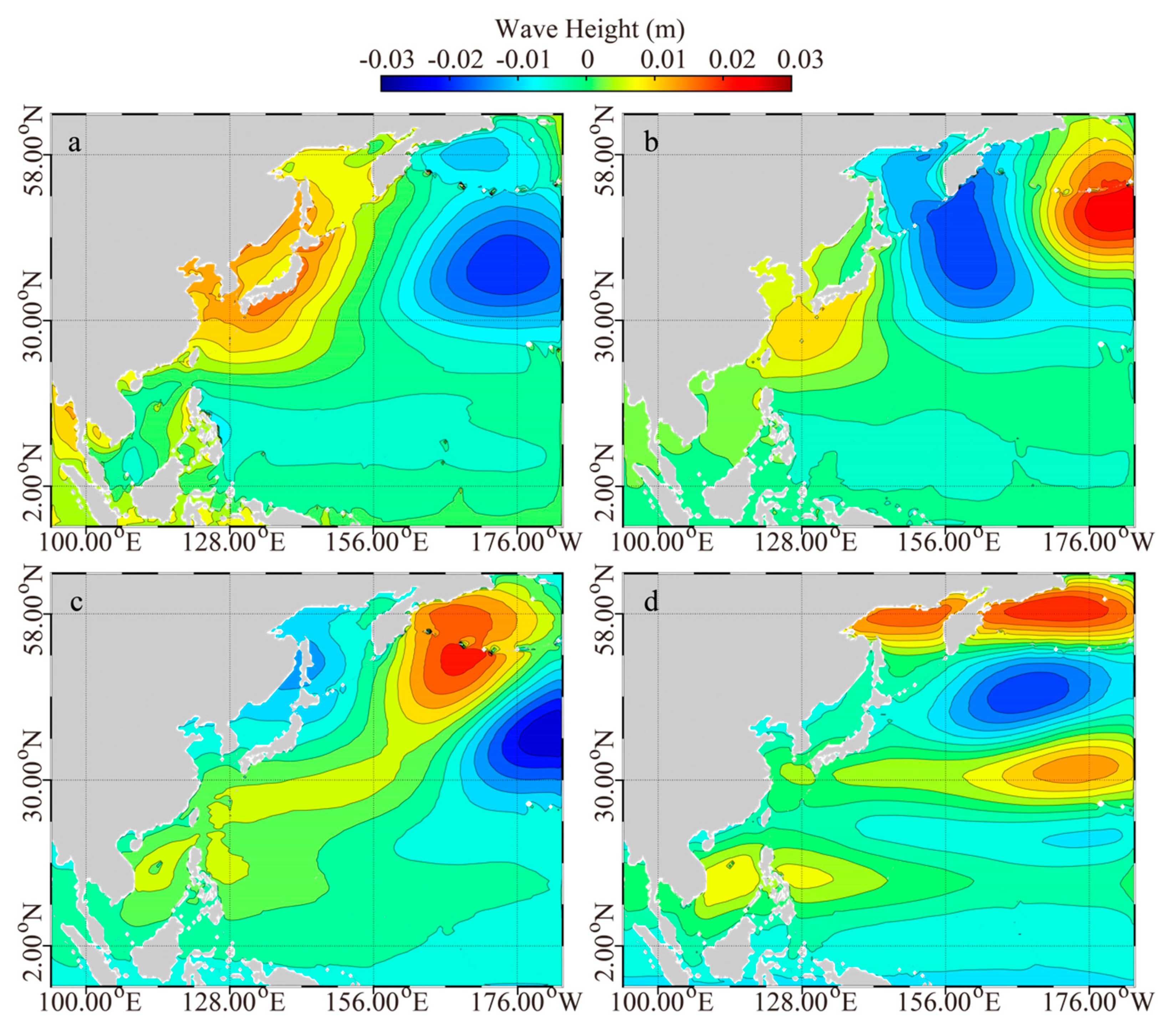
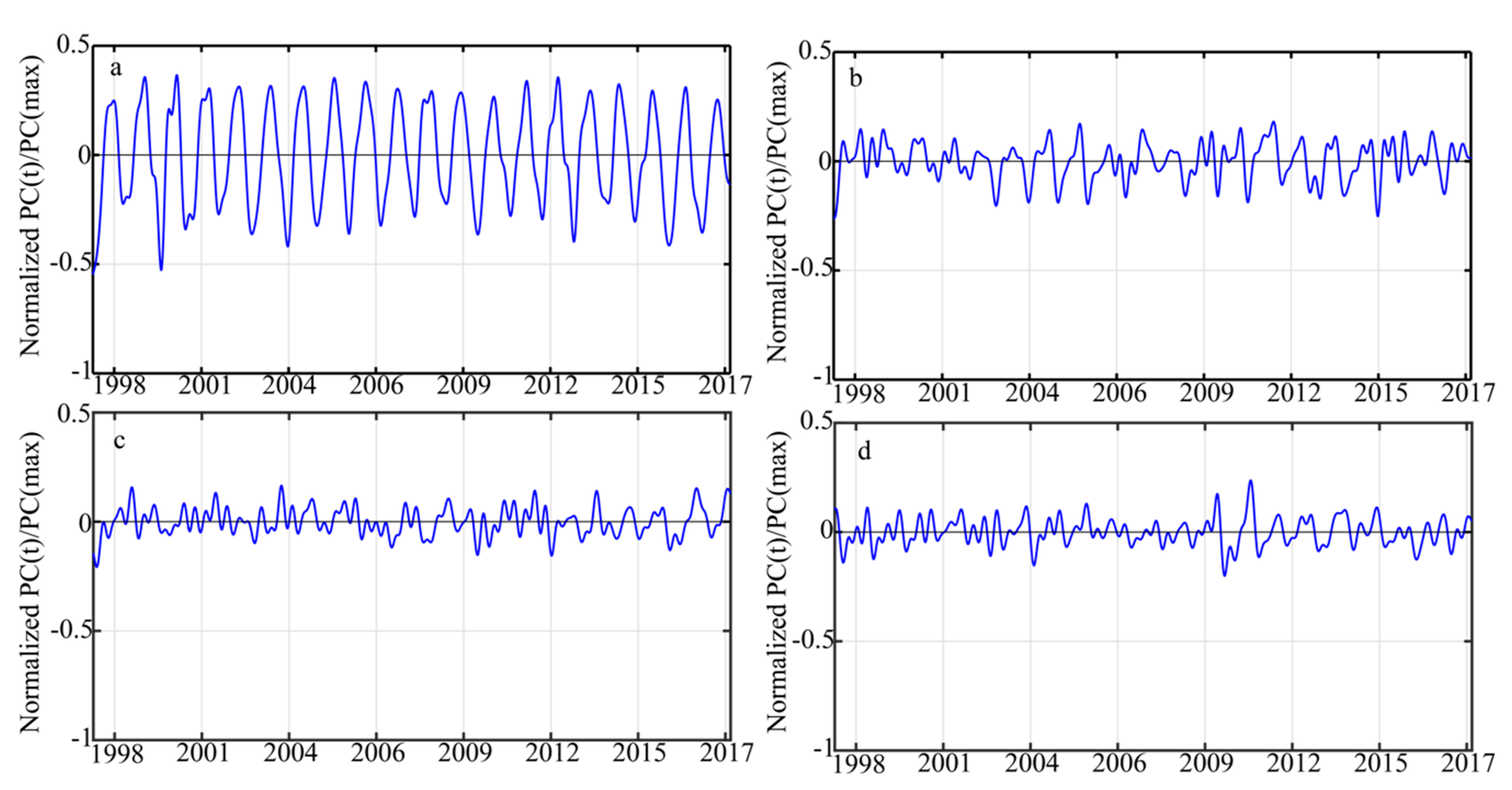
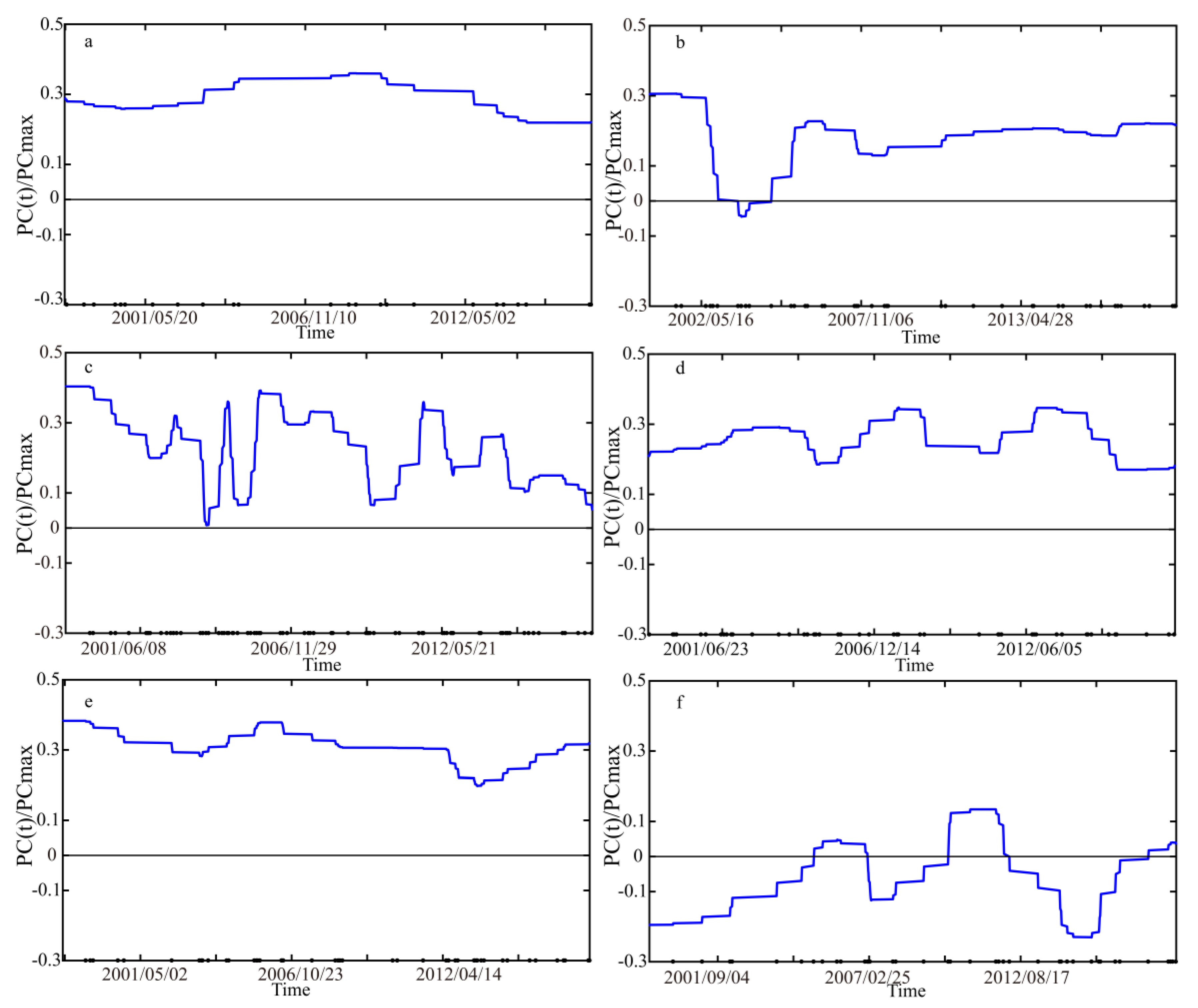
| Modes | ej | λj − λj + 1 | |
|---|---|---|---|
| 1 | 450.7115 | 7.4577 | 230.7340 |
| 2 | 219.9775 | 3.6398 | 36.5925 |
| 3 | 183.3850 | 3.0344 | 24.3827 |
| 4 | 159.0023 | 2.6309 | 26.6687 |
© 2020 by the authors. Licensee MDPI, Basel, Switzerland. This article is an open access article distributed under the terms and conditions of the Creative Commons Attribution (CC BY) license (http://creativecommons.org/licenses/by/4.0/).
Share and Cite
Hu, Y.; Shao, W.; Wei, Y.; Zuo, J. Analysis of Typhoon-Induced Waves along Typhoon Tracks in the Western North Pacific Ocean, 1998–2017. J. Mar. Sci. Eng. 2020, 8, 521. https://doi.org/10.3390/jmse8070521
Hu Y, Shao W, Wei Y, Zuo J. Analysis of Typhoon-Induced Waves along Typhoon Tracks in the Western North Pacific Ocean, 1998–2017. Journal of Marine Science and Engineering. 2020; 8(7):521. https://doi.org/10.3390/jmse8070521
Chicago/Turabian StyleHu, Yuyi, Weizeng Shao, Yongliang Wei, and Juncheng Zuo. 2020. "Analysis of Typhoon-Induced Waves along Typhoon Tracks in the Western North Pacific Ocean, 1998–2017" Journal of Marine Science and Engineering 8, no. 7: 521. https://doi.org/10.3390/jmse8070521






